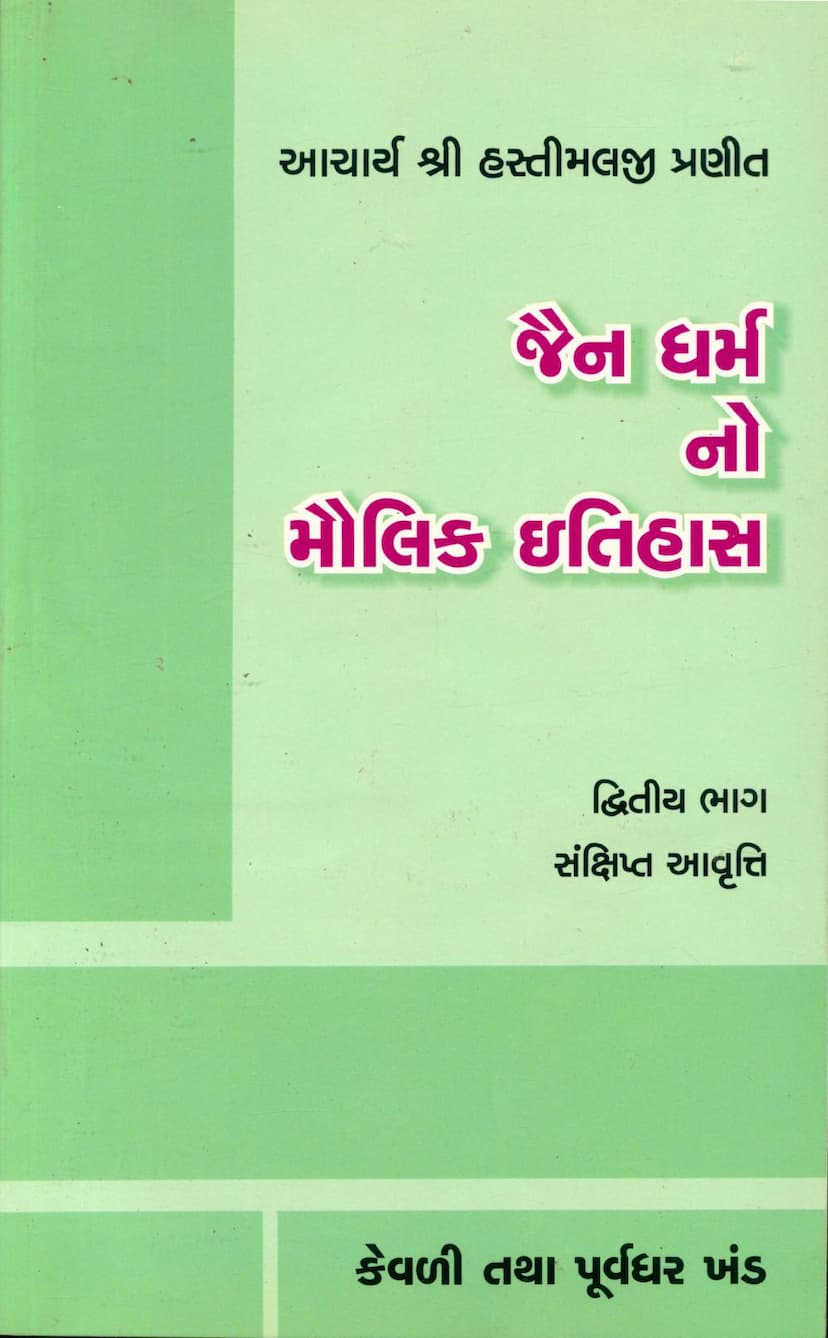Jain Dharmno Maulik Itihas Part 02 Kevali Tatha Purvdhar Khand
Added to library: September 2, 2025

Summary
This comprehensive summary outlines the content of "Jain Dharmno Maulik Itihas Part 02: Kevali Tatha Purvdhar Khand" by Acharya Hastimal Maharaj, a significant work in Jain historiography. The book, published by Samyag Gyan Pracharak Mandal, Jaipur, delves into the history of Jainism from the period of the Kevalis (omniscient beings) to the Purvdharas (keepers of the Purvas, ancient Jain scriptures).
Key aspects covered in the book:
-
Chronological Scope: The second part of the history covers the period from the Veera Nirvana Samvat (V.N.S.) 1 to 1000 (approximately 527 BCE to 473 CE). This vast timeframe is meticulously divided into four key periods:
- Kevali Kaal (Period of Kevalis): This section focuses on the omniscient beings who attained perfect knowledge after Lord Mahavir. It details the lives and teachings of Indra-bhuti Gautama, Arya Sudharma, and Arya Jambu Swami, considered the immediate successors of Lord Mahavir. The book discusses the differing traditions between Shvetambara and Digambara regarding their periods of Kevalihood and the compilation of the Dwadasangi (the twelve limbs of Jain scripture).
- Shrutkevali Kaal (Period of Shrutkevalis): This phase covers the era of the Shrutkevalis, those who possessed the knowledge of all twelve Angas of the Jain scripture. It highlights the lives of prominent figures like Aryas Prabhava, Sambhav, Yashobhadra, Sambhutivijaya, and Bhadrabahu, discussing their contributions, the events during their times, and the differences in their traditions between Shvetambara and Digambara. A significant focus is placed on resolving historical discrepancies regarding the timeline and lineage of these figures, particularly Bhadrabahu.
- Dashapurvdhar Kaal (Period of Dashapurvdhars): This section details the lives of the Dashapurvdhars, those who possessed knowledge of the ten preceding Angas of the scripture. It covers the period from Arya Sthulabhadra to Arya Vajraswami, chronicling their activities, the significant historical events of their times, interactions with contemporary dynasties, and foreign invasions. The book attempts to unravel complex chronological issues and clarify prevalent misconceptions.
- General Purvdhar Kaal (General Period of Purvdhars): This final segment of the book covers the era from Arya Rakshit to Aryadevadhikshama Shraman. It introduces figures like Arya Rakshit, Arya Mangunath, Arya Vajraswami, and others, discussing their roles in preserving and disseminating Jain knowledge. It also explores the evolution of sects within Jainism, the reasons for sectarian divisions, the emergence of different gacchas (lineages), the practice of Chaityavaas (living in temples), and the significant event of the final compilation of Agamas in Vallabhi.
-
Key Themes and Features:
- Factual and Critical Analysis: The book aims for a factual and analytical presentation of Jain history, critically examining events and texts.
- ** आचार्य Tradition:** It meticulously traces the lineage and contributions of the Jain Acharyas, highlighting their pivotal role in preserving and propagating the faith.
- Dwadasangi and Purva Knowledge: A significant portion of the book is dedicated to the gradual decline and eventual disappearance of the knowledge of the Purvas (ancient scriptures) and the efforts to preserve the Dwadasangi.
- Socio-Political Context: The text places Jain history within its broader socio-political context, discussing the influence of contemporary dynasties, political events, and foreign invasions.
- Addressing Complex Issues: It tackles intricate historical problems, resolves misconceptions, and sheds new light on obscure chapters of Jain history.
- Contribution of Women: The book highlights the significant contributions of women in Jainism as Shramanis (nuns) and Shramanopasikas (female lay followers).
- Accessible Language: The author's profound knowledge is presented in a lucid, simple, and engaging language, making a complex subject accessible to a wide readership.
- Emphasis on Original Sources: The author's research is grounded in ancient Jain scriptures, commentaries, historical texts, inscriptions, and other primary sources.
- Rejection of Speculation: The book prioritizes historically verifiable facts over imaginative narratives, ensuring a grounded historical account.
-
Specific Figures and Events Discussed:
- Kevali Kaal: Detailed accounts of Gautam Swami, Sudharma Swami, and Jambu Swami.
- Shrutkevali Kaal: Lives and contributions of Prabhava, Sambhav, Yashobhadra, Sambhutivijaya, and Bhadrabahu, including a detailed discussion on the confusion surrounding the identity and timeline of different Bhadrabahus.
- Dashapurvdhar Kaal: Focus on Sthulabhadra, Mahagiri, Suhasti, Shyaam (Kalkacharya I), Shandilya (Skandil), Revati Mitra, Dharma, Bhadra Gupta, Vajraswami, Rakshit, and others. The book explores the complexities of chronological calculations and the historical context of the period.
- General Purvdhar Kaal: Covers figures like Rakshit, Samudra, Vajraswami, Nagahasti, Revati Mitra, Singh, Nagarjun, Bhutadinna, Kalkacharya (II), and Saty Mitra, with discussions on sectarian divisions, the origin of Gachhas, Chaityavaas, and the compilation of Agamas.
-
Key Characteristics of the Work:
- Scholarly Rigor: Acharya Hastimal Maharaj's profound scholarship is evident in his critical analysis of various sources and traditions.
- Comprehensive Coverage: The book provides a thorough and systematic account of a significant period in Jain history.
- Clarification of Disputes: It addresses historical debates and discrepancies between Shvetambara and Digambara traditions with a balanced and well-researched approach.
- Historical Context: The book situates Jain history within the broader Indian historical narrative, connecting it with political events and ruling dynasties.
In essence, "Jain Dharmno Maulik Itihas Part 02" is a monumental work that meticulously reconstructs the early history of Jainism, focusing on the foundational figures and the transmission of knowledge from the time of the omniscient beings to the era of the Purvdhars. It serves as an invaluable resource for scholars and practitioners seeking a deep understanding of Jain traditions and their historical development. The summary also highlights the efforts in creating a Gujarati version for wider accessibility.